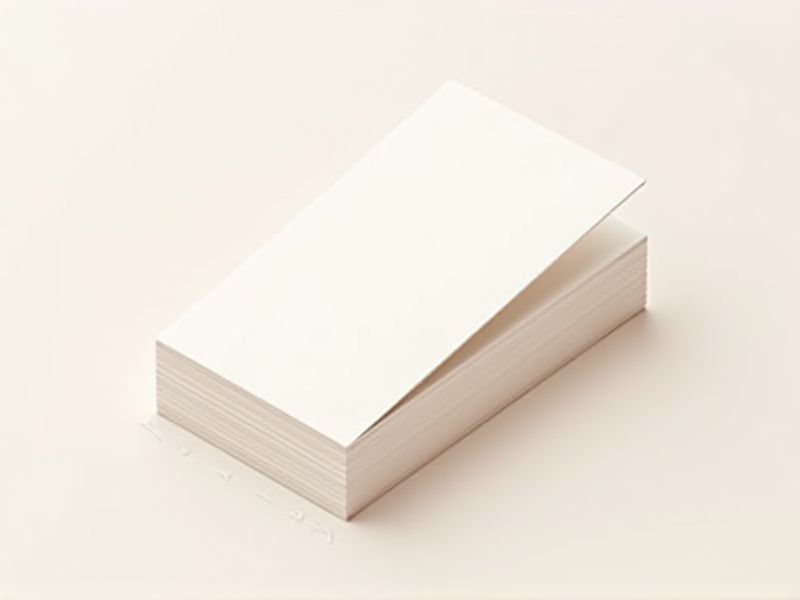
The standard dimensions of a business card are typically 3.5 inches wide by 2 inches tall (88.9 mm x 50.8 mm). These dimensions ensure the card fits easily into wallets, cardholders, and business card organizers, making it practical for everyday use. When designing your card, it's helpful to keep a safe margin (usually about 0.125 inches or 3 mm) around the edges to prevent important text or logos from being cut off during printing. By following these standard dimensions, you ensure your business card looks professional and is compatible with common storage solutions.
3.5 Inches By 2 Inches Dimension
The standard business card measures 3.5 inches in width and 2 inches in height, making it a compact tool for networking. This size allows for easy storage in wallets and cardholders, ensuring you can always have your information readily available. Typically printed on cardstock with a thickness of 14 to 16 pt, these cards also offer durability and a professional feel. Customization options, such as matte or glossy finishes, can enhance the visual appeal, making your business card stand out in a competitive market.
Portrait Or Landscape Orientation
A standard business card typically measures 3.5 inches by 2 inches and can be oriented in either portrait or landscape format. The portrait orientation, which is vertical, often emphasizes the name and contact information, making it a popular choice for professionals seeking a classic and formal appearance. In contrast, a landscape orientation allows for a more spacious layout, ideal for including logos and additional branding elements, appealing to creative industries. Choosing the right orientation depends on your branding goals and the impression you wish to convey to potential clients or partners.
0.125-Inch Bleed Area
A standard business card typically measures 3.5 inches by 2 inches, which is crucial for effective branding and networking. Incorporating a 0.125-inch bleed area ensures that your design extends beyond the cut line, preventing any unsightly white edges post-printing. This design practice is essential for achieving a professional look, especially when using full-color graphics or images. Consider investing in high-quality paper stock with a minimum weight of 14pt for added durability and a premium feel.
Standard Card Stock Thickness
The standard business card typically features a thickness of 14 to 16 points, equivalent to approximately 0.014 to 0.016 inches. This thickness provides a professional appearance and ensures durability, making it less susceptible to bending or damage during handling. Using card stock within this range enhances print quality, allowing colors and designs to appear vibrant and clear. When selecting your business card, consider that the thickness plays a crucial role in creating a favorable first impression.
Finish Options (Matte Or Glossy)
The standard business card typically features a choice between matte and glossy finishes, each offering unique advantages for your professional presentation. A matte finish provides a non-reflective surface that can enhance readability and is often preferred for conveying a more sophisticated image, while a glossy finish offers vibrant color reproduction and a polished look that can make your card stand out. Depending on your design, a matte card can be easier to write on, allowing you to add a personal touch or notes during networking events. When selecting between the two, consider how the finish aligns with your brand identity and the impression you want to leave with potential clients or partners.
Corner Options (Rounded Or Square)
When designing your business card, consider the two primary corner options: rounded and square. Rounded corners offer a softer, modern aesthetic that can enhance the overall look, while square corners provide a classic and professional feel. The choice between these options can impact the perception of your brand, with rounded corners often associated with friendliness and innovation, while square corners convey stability and tradition. Standard dimensions for business cards typically measure 3.5 by 2 inches, making the corner selection critical to maintaining a polished appearance.
Cmyk Color Model
The standard business card typically measures 3.5 x 2 inches, making it easy to carry and distribute. For optimal color reproduction, the CMYK color model--comprising Cyan, Magenta, Yellow, and Key (Black)--is essential in print design, ensuring vibrant and accurate color outcomes. Standard printing resolution is generally set at 300 DPI (dots per inch), which is crucial for maintaining clarity and crispness in your designs. When creating your business card, it's vital to use a bleed area of 0.125 inches to prevent any unintended white edges in the final print.
Standard Aspect Ratio 1.75:1
A standard business card typically adheres to an aspect ratio of 1.75:1, ensuring a polished and professional appearance. The common dimensions for this aspect ratio result in a size of approximately 3.5 inches by 2 inches, providing ample space for essential information. Utilizing this ratio not only enhances readability but also facilitates easy storage in wallets and cardholders. By following this standard, your business card aligns with industry expectations, making you stand out in networking opportunities.
Common Weight 300-400 Gsm
A standard business card typically features a common weight ranging between 300 and 400 GSM (grams per square meter), which ensures durability and a professional appearance. Cards with this weight provide a premium feel, making them less prone to bending or tearing. When you choose a card within this range, you enhance your brand's image, as thicker cards often convey reliability and quality. The optimal GSM selection can significantly influence the first impression you make on potential clients or partners.
Standard Margin Around Text
The standard business card measures 3.5 inches by 2 inches, with a recommended margin of 0.125 inches around the text to ensure legibility and visual appeal. This margin helps avoid important information getting cut off during printing and helps maintain a professional look. You should consider using a clear, easy-to-read font in a size that complements the card's design, typically between 10 to 12 points. Incorporating a consistent color scheme with your branding further enhances the impact of your business card while adhering to these standard margins.
